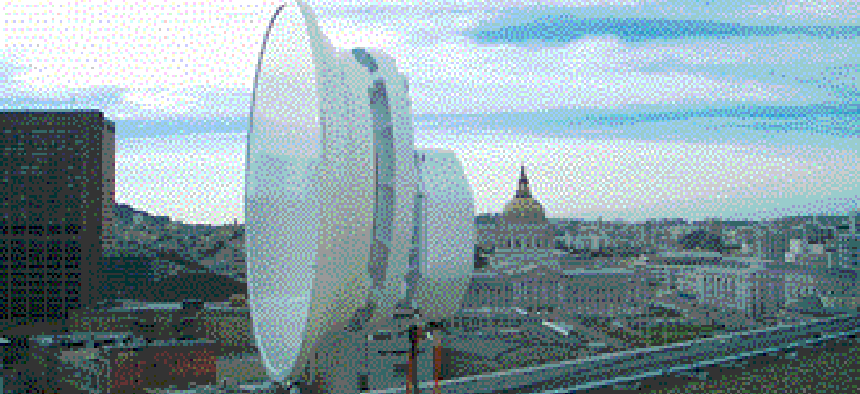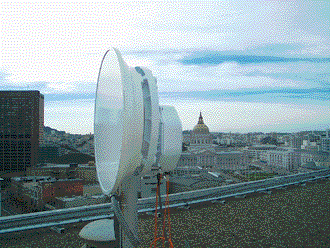San Francisco project taps radio waves for connectivity

Much of downtown San Francisco is wired with fiber-optic cable to serve the broadband needs of city agencies and departments. But for the water-pump stations for the city and county of San Francisco, a broadband connection was out of reach. The San Francisco city and county Public Works Department hired Xtech LLC to connect the pump stations, said John Eaton, an Xtech partner.
From Market Street to Lombard Street, much of downtown San Francisco is wired with fiber-optic cable to serve the broadband needs of city agencies and departments. But for the water-pump stations for the city and county of San Francisco, a broadband connection was out of reach.The San Francisco city and county Public Works Department hired Xtech LLC, a San Francisco systems integrator, to connect the pump stations, said John Eaton, an Xtech partner."The Public Works Department's goal was to get high-speed connectivity out to all the pump stations to monitor what was going on there," he said. The stations typically used T1s, even multiple T1s, to get bandwidth to these locations, "but that's pretty expensive and pretty slow, relative to new technologies," he said.For maintenance and homeland security purposes, San Francisco wanted real-time video monitoring and data transfer at every station. The old data lines weren't nearly big enough to get the job done. While the core areas around city hall have fiber available for network connectivity, that wasn't the case at the pump stations."Pump stations are miles away from the fiber ring, and running fiber out to a station would be hundreds of thousands of dollars minimally," Eaton said.The solution, the city decided, was to use wireless links from GigaBeam Corp. of Herndon, Va. The company's GigaBeam WiFiber products are point-to-point radio technology designed to connect buildings with facilities, said John Krzywicki, a GigaBeam vice president.The radios operate at 1.25 Gbps in each direction. Often, the radios are used to connect data centers, or for a remote site, to provide backhaul connectivity, that is, back to the central site.Typically, the links are between three-quarters of a mile to a little less than two miles. In dry air, the link can travel 10 miles. GigaBeam has an eight-mile connection running in the island nation of Bahrain in the Persian Gulf, for example.Even in rainy areas of the United States, downtime is usually less than five minutes a year, Krzywicki said.GigaBeam WiFiber products operate in the 71-GHz to 76-GHz and 81-GHz to 86-GHz radio spectrum bands, the frequency spectrum authorized by the Federal Communications Commission for wireless, point-to-point commercial use."There is a very simple licensing procedure," Krzywicki said. "For the holder of the licenses, such as San Francisco, there is a two-step process: First, a paper filing with the FCC where the user receives a registration number. Then, each time you want a new circuit, you take the registration number and go to the Web, file the position of the first end of the circuit, the position of the second end of the circuit, and a couple of other details."Each new circuit license costs $300, lasts 10 years and is renewable.GigaBeam's technology differs from the WiMax 802.16 standard in that it is designed to go only point to point. WiMax primarily broadcasts from a single point to multiple points. WiMax does not need a clear line of sight to transmit, whereas GigaBeam does."That characteristic of one radio being able to go out to many different receivers is very valuable, but what it does is break down the bandwidth into smaller increments," Krzywicki said.The bandwidth for WiMax is in the one megabit to two megabit range."Our radios only go point to point and get a gigabit's worth of bandwidth instead of increments of one to two megabits at a time; that adds up to 30 to 50 megabits total on a given radio," Krzywicki said. "In other words, we have 20 times the bandwidth."In San Francisco's case, that bandwidth is being used to deliver network connectivity to each pump station. There, 802.16 WiMax and 802.11 wireless fidelity standards technology is used to divvy up the bandwidth among video cameras and other systems, Eaton said.San Francisco has seven links or nodes in a ring connecting the pump stations. Each node has a WiMax transmitter that sends a single broadcast to the cameras, voice over IP phones and computers to manage the pumps, valves, reservoirs, dams and other waterworks facilities."This is a WiMax application that's being backhauled GigaBeam," Krzywicki said.To run fiber along the same routes, where there is no conduit space, could have cost up to $1 million a mile, Krzywicki said. It cost less than $50,000 a mile to go wireless, he said.GigaBeam technicians work extensively with systems integrators in installing the technology."Systems integrators do the raw installation, maintenance, etc., with our assistance," Krzywicki said. In general, the biggest challenge to the project was its design and ensuring site lines could be established from node to node, Eaton said. Small details, such as getting power to and a clear signal on the roof, were concerns, he said. "It sounds easy, but getting power and signal to the roof is challenging," he said. "The general design, doing your measurements, and getting the coordinates is actually the hardest part. The physical installation of the radios is pretty straightforward, it only takes an hour or two to bring up a link."Integrators design the infrastructure to distribute the signal. The technology uses industry-standard Gigabit Ethernet protocols. The GigaBeam system has a fiber-in port, fiber-out port, a power cord and a third cord for networking monitoring systems.San Francisco officials plan to beef up the wireless system to serve other needs in the future."This further deployment will allow us to take advantage of the throughput capacity and cost effective bandwidth of the WiFiber links for additional applications, including geographic information system mapping, VoIP and general backhaul of data," said Hans Loffeld, IT director of the San Francisco Public Utility.Other projects in San Francisco are using GigaBeam as a backup for fiber-cable rings, including the 311 non-emergency call center and 911, said Eaton."It's a way to get fiber's performance and reliability, without having to spend the kind of money it takes to run fiber half a mile to two miles," Eaton said.If you have an innovative solution that you installed in a government agency, contact Staff Writer Doug Beizer at dbeizer@postnewsweektech.com.

Points of contrast

San Francisco's wireless backhaul requires unblocked sight lines.
Courtesy Rubenstein Public Relations
Points of contrast
NEXT STORY: Sun shines hot on the grid

